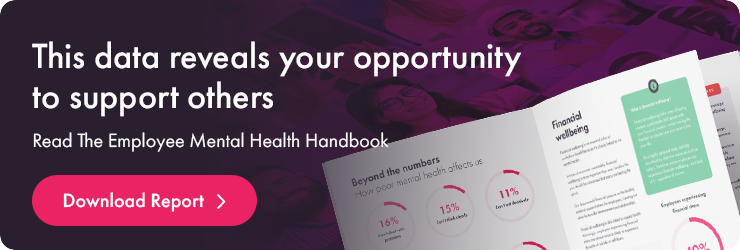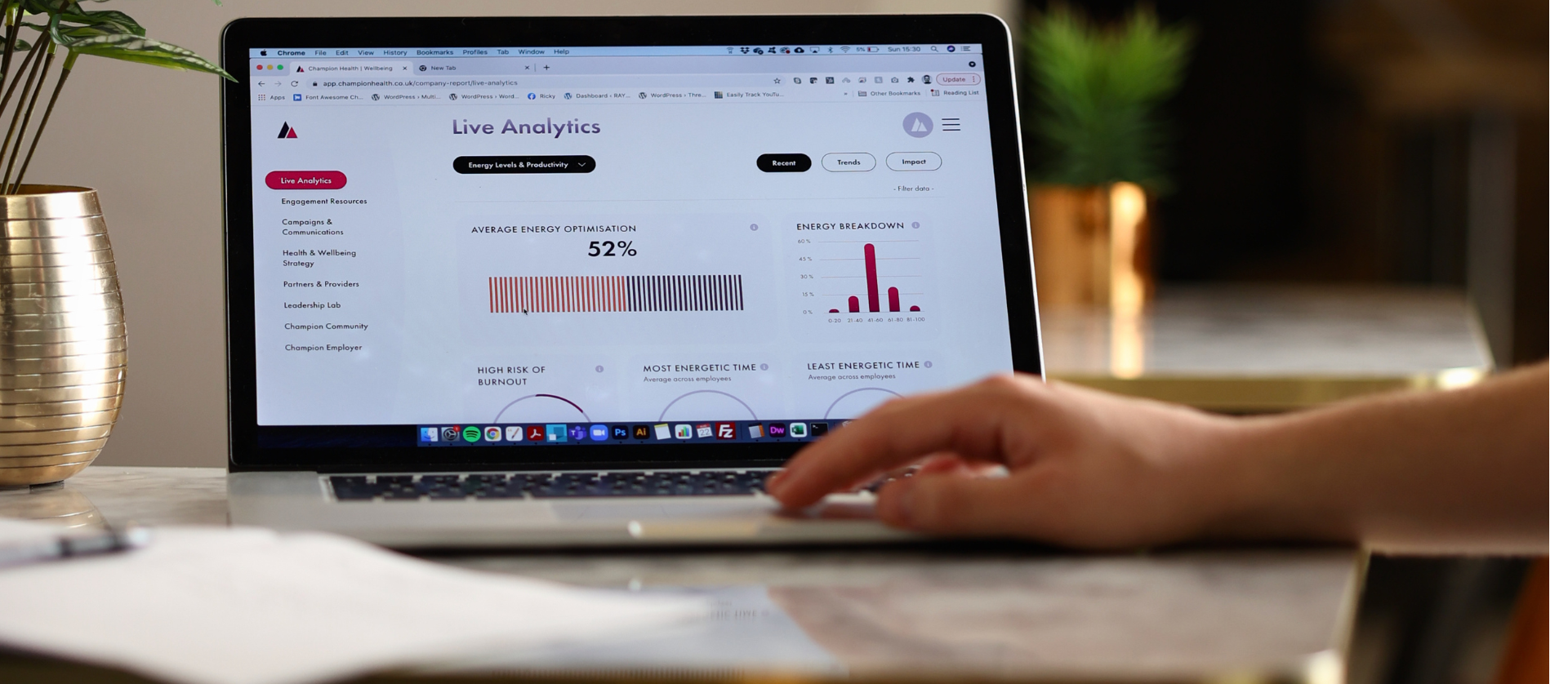Panic attacks at work are extremely difficult to manage and are often very distressing for those experiencing them.
As a leader in your organisation, you can make a real difference to the lives of these employees, by knowing how to support them.
During a panic attack, not only will the individual have to deal with extremely distressing symptoms, they may have to do it in front of the people they spend 40 hours a week with. This is a situation that they may find not only distressing, but embarrassing.
You may also find that your employees go to great lengths to keep their panic attacks a secret from their colleagues and managers, which can make the symptoms of attacks even more severe when they occur.
This makes it even more important that these individuals are properly supported. In this guide, you’ll learn:
- What is a panic attack?
- What triggers a panic attack?
- What are the symptoms of a panic attack?
- How to support a colleague who is experiencing panic attacks
- What to do if a colleague has a panic attack
- How to manage panic attacks at work
What is a panic attack?
The first thing to know about panic attacks is that they are not dangerous; they are in fact part of a system that’s designed to protect us.
This system is our body’s normal, natural response to danger, and it’s rooted in our evolutionary history.
When we’re faced with something threatening, our body primes itself to either fight or run away, making our heart beat faster, accelerating our breathing and diverting oxygen-rich blood to our muscles.
During a panic attack, the same fear response is triggered, but there’s often no actual danger to respond to.
It’s like the burglar alarm that gets set off by the cat. Your body readies itself to be attacked, but there’s nothing to be ready for.
The result is a highly unpleasant and frightening experience.
What triggers a panic attack?
Panic attacks are not logical or predictable experiences, which is part of the reason why they’re so scary.
More often than not, a panic attack can happen out of the blue and come on without any warning signs.
This can make it difficult to understand what’s happening and can lead people to misinterpret the symptoms for something more life-threatening like a heart attack.
For others, there might be a particular situation that triggers an attack, such as a crowded place or another anxiety-provoking situation.
These situations may also be work-related, such as presentations, team meetings or performance reviews with managers.
What are the symptoms of a panic attack?
Panic attacks can cause all sorts of intense physical symptoms, such as shortness of breath, a tight chest, dizziness and nausea.
Alongside these, the person may also be hit with a sudden feeling that something awful is going to happen.
Although the symptoms of a panic attack are harmless, and usually pass quite quickly, they can have a lasting effect on those who experience them.
For example, it can make people feel more fearful of being in the same situation in case it triggers another attack, leading to avoidance of that situation altogether.
And whilst this can ease anxiety in the short-term, it only makes the panic worse in the long-term, keeping the person stuck in this vicious cycle.
How to support a colleague who is experiencing panic attacks
Just as panic attacks can be extremely daunting for those who are facing them, it may also feel daunting for those who try to help them.
If you think one of your team is struggling, or you find out that a colleague is experiencing panic attacks, it may understandably be difficult to know what to do.
With that in mind, here are five actionable steps you can take to support employees and colleagues who experience panic attacks.
1. Create an open environment
It’s a wonderful thing that the stigma around mental health is slowly being broken down – and it is getting increasingly easier to discuss mental health issues with colleagues and employees.
Unfortunately, some stigma still remains, and this can make employees fearful of disclosing mental health issues at work.
For people who experience panic attacks, keeping them a secret can cause additional distress when the attacks occur.
As a leader, you can make a difference, by promoting honest and open conversation around mental health.
By doing this, you can create an environment where your employees feel able to discuss their panic attacks with their colleagues – and with you.
This can reduce the stress surrounding their attacks, which may help reduce the severity of their symptoms.
It also puts you in a better position to help. If your colleague feels able to discuss their panic attacks with you, it means that you can work together on creating a work environment which is more comfortable for them.
2. Allow time for recovery
Although panic attacks are often short-lived, the after-effects can take some time to wear off. They can leave an individual shaken, exhausted and actually quite debilitated.
Make it clear to the employee that they don’t have to return to work straightaway – allow them to take as much time as they need.
Simply knowing that they have these allowances available may help the individual feel less shaken and pressured in the aftermath of an attack.
3. Maintain regular communication with colleagues
Regularly communicating with your colleagues and employees gives them the opportunity to discuss any issues they’re having, and you the opportunity to let them know you can support them.
In the case of panic attacks, it may also enable the employee to open up more about how they are affected, especially if they feel supported.
This allows you to pick up useful information, such as how often attacks occur, what may trigger them, and the ways that you can help in the event of the employee experiencing an attack.
We recommend following The CLASS Approach to supporting others to help you connect and maintain that conversation.
4. Implement reasonable adjustments
Reasonable adjustments for mental health issues should be a core part of wellbeing strategies – and panic attacks are no different.
If one of your team experiences panic attacks regularly, take the time to discuss with them how you can adjust their working environment to help them.
By doing this, you can reduce part of the anxiety that surrounds their panic attacks.
It could be something as simple as offering them the opportunity to work from home, or creating a space where they can get away from other people.
5. Signpost
You’re not expected to be an expert on panic attacks, and nor should you take on that responsibility.
However, you can make a difference by showing your support and understanding the best places to signpost a struggling employee.
These could be internal services, like an employee assistance programme (EAP), or occupational health, or external services, like their GP.
What to do if a colleague has a panic attack
Panic attacks are an extremely personal experience, and there is no one-size-fits-all approach to helping someone who is experiencing one.
It’s important not to make assumptions about what somebody needs. Different things will work for different people, so you need to ask what works best for them.
In general, try to act in a controlled, measured and predictable way. Speak in simple, clear sentences, and reassure the person that what they’re going through will be over quickly.
It also helps if you can help them slow their breathing down. You can do this by breathing with them and modelling slow, controlled breaths. Champion Health’s breathing bubble will help with this.
How to manage panic attacks at work
If you experience panic attacks in work, then it can be an extremely distressing experience, and it is often difficult to know how to make the experience any less uncomfortable.
With that in mind, here are six steps you can take to help manage your attacks while at work and create an environment in which you feel more comfortable and able to work at your best.
1. Identify your triggers
While panic attacks can often occur out of the blue, there may also be common situations that will trigger anxiety and other symptoms.
Knowing what these triggers are can help you to formulate a plan for when you encounter them.
2. Recognise your symptoms
Recognising your symptoms means knowing how your body feels in the build-up to a panic attack and identifying the thought processes that you will undertake during this time.
If you can recognise these symptoms, then you can respond quickly when you feel that a panic attack might be beginning – you might even be able to intervene quickly enough to reduce the severity of an attack.
3. Choose and develop your coping techniques
There are a wide range of coping techniques available for people who experience panic attacks, from breathing exercises, to grounding techniques and beyond.
Some of those techniques are outlined in these resources from Mind and the NHS. You can also work with a therapist to explore different coping techniques in more detail.
Once you’ve learned about the different techniques that are available, you can set to work finding out which ones work best for you.
Hone these coping techniques by practicing them in a relaxed state. That way, if an attack occurs, you can draw on your tried, trusted and developed techniques to relieve your symptoms.
4. Access the right support
If you’re experiencing panic attacks frequently and they’re having an impact on your day-to-day life, there is support out there for you.
You could make an appointment with your GP who can refer you onto specialist support, or you can self-refer to the NHS therapies service directly.
This will give you the opportunity to talk about your panic attacks with a trained professional, helping you to manage the symptoms, identify the potential causes, and work on ways to break your own personal panic cycle.
There are a number of different techniques that can help you do this, such as distraction techniques, graded exposure and controlled breathing or meditation. You’ll be given the chance to find what works best for you.
5. Be open with your colleagues
It’s common for those who experience panic attacks to hide them from their colleagues and managers.
Opening up about your mental health is your choice, and you are never obliged to declare any mental illness to your employer or your colleagues.
However, if your panic attacks are significantly affecting your work, it can be liberating to let those you work with know.
By opening up to them, you are giving your employer the opportunity to appropriately support you; ultimately, they can only help with issues they know about.
If you’re worried about the reverse occurring, remember that it is illegal for anyone in the workplace to discriminate against you because of a mental health issue.
Read this guide on how to talk about mental health at work for helpful tips on how to approach this conversation.
6. Remember that it’s not a reflection on you
Panic attacks do not define you – they bear no reflection on who you are as a person, or your capability as an employee.
It’s incredibly important that you remember that because it is common for employees to feel awkward or embarrassed in the aftermath of a panic attack.
If you struggle with panic attacks regularly, then you are one of undoubtedly several people in your office who are experiencing difficulties with mental health.
Nobody has to confront panic attacks alone
Panic attacks can be a tough thing to confront, but it’s important to remember that they’re treatable, and nobody has to confront them alone.
Whether it’s you, or someone you work with, as soon as the person is ready, the support is there to guide them through this process, so they shouldn’t be afraid to reach out for help.
By following some of the advice in this guide, you can play your part in supporting your colleagues and employees, and creating an environment where they still feel capable and confident of working to their best.






